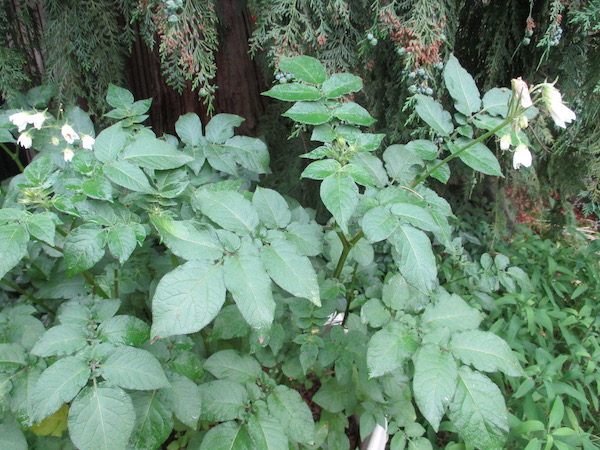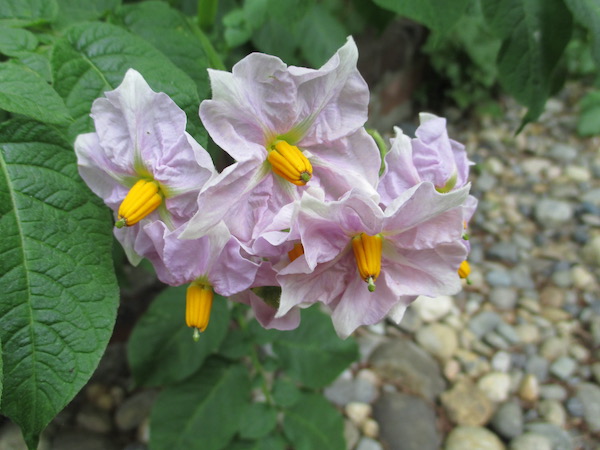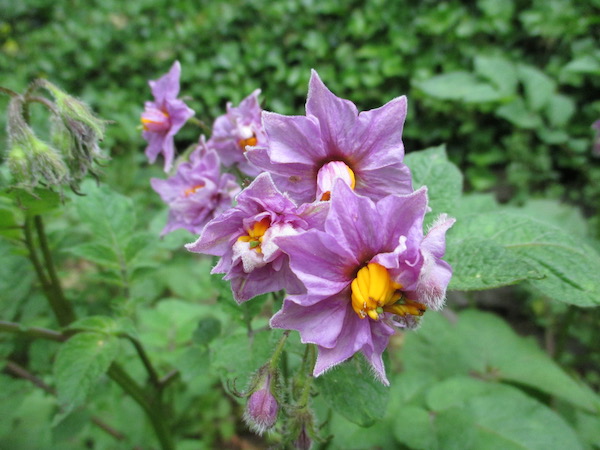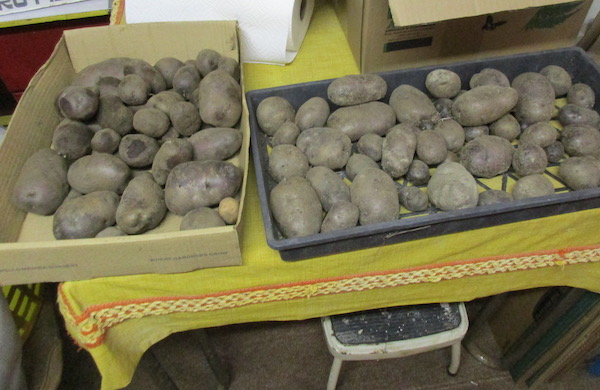| Most people reading this, have eaten potatoes in one preparation or another. Many have grown and harvested them. I have, too, making home-made French fries, and whatnot. Few people know much about potatoes. For several reasons, I choose to feature the potato plant this month. |
| To begin with, the species is earth's fifth highest ranking food crop, as measured in tons produced annually. The top four are all members of the grass family. Potato is the most important vegetable crop in the world. Potatoes are often thought of as essentially a carbohydrate source, yet if their skins are eaten rather than peeled, they supply protein. In fact, an acre of potatoes makes more protein than an acre of soybeans. |
| The potato we know today, was first domesticated in the Andes of south Peru about 10,000 years ago. Taxonomy of cultivated potatoes is controversial, with disagreement as to what species are recognized, and what taxa are hybrids --but all form a common gene pool. There are wild potato species, rare cultivated species, and common species, plus hybrids. It is similar in this regard to the tomatoes. |
At least 31 Solanum species with potato-like tubers have been eaten by humans:
|
| S. acaule Bitt. |
| S. Ajanhuiri Juz. & Bukasov |
| S. aridum Morong |
| S. bulbocastanum Dun. |
| S. Candolleanum Berthault |
| S. cardiophyllum Lindl. |
| S. Cari Mol. |
| S. chacoense Bitt. |
| S. Chaucha Juz. & Buk. |
| S. Commersonii Dun. |
| S. curtilobum Juz. & Bukasov |
| S. demissum Lindl. |
| S. edinense Berthault |
| S. Ehrenbergii (Bitt.) Rydb. |
| S. etuberosum Lindl. |
| S. Fernandezianum Phil. |
| S. Hieronymi Ktze. |
| S. immite Dun. |
| S. infundibuliforme Phil. |
| S. Jamesii Torr. |
| S. Juzepczukii Bukasov |
| S. Maglia Schltdl. |
| S. montanum L. |
| S. multiinterruptum Bitt. |
| S. nitidum R. & P. 1799, non Pav. ex Dun. 1852 |
| S. oxycarpum Schiede |
| S. Phureja Juz. & Bukasov |
| S. stenotomum Juz. & Bukasov |
| S. stoloniferum Schltdl. & Bouché |
| S. Vernei Bitt. & Wittm. |
S. verrucosum Schltdl.
|
| As with many plants people eat, potato qualifies as both poisonous and edible. Poisoning of humans is caused by consuming sprouted, greened, small, or otherwise imperfect potatoes or other parts of the potato plant containing sufficient steroidal glycoalkaloids. The level varies with the species, cultivar, plant part, and time of year. Though the steroidal glycoalkaloids are in all parts of the plants, they seem least common in the mature tuber flesh, and most common in the fruit. Solanum alkaloids are diverse; the best known is solanine. Glycosides can cause gastro-intestinal effects, but solanine is rapidly hydrolysed to the less toxic aglycone in the gastro-intestinal tract. Moreover, solanine is absorbed poorly in the gastro-intestinal tract. The bottom line is that while many people get sick from eating potatoes sometimes, they almost all recover rather than die. |
| In various places (Africa, Italy, Caucasus, Kosovo, Mexico), the young leaves of the potato plant are cooked as greens. I have done so. I also tried cooking the ripe berries. They smelled good, tasted good, but made me sick. |
| Not all potato cultivars bear blossoms and set berries. I show photos of some potato flowers in my former garden. They can be lovely. |
| The potato has the distinction of being the single crop that will yield the most calories in one year in Seattle cultivation. It is planted after the last spring frost (March or April), and harvested (it varies with the cultivar, the growing conditions, blight, and the year) in summer, early to late fall. Some plants have their tops wither away in August, while others stay green into November. Overall, it is a cool-season crop. Perfect for this Solar Minimum period. |
| You can grow potatoes in the ground, or in containers, but for the largest yields and ease of harvest, it is best to grow them in piles of compost, wood chips, and the like. |
| After harvest, you cure the tubers by a partial drying, then store them in a cellar or cool, dark, place. If the place is too warm or humid they can sprout. Some people dehydrate their potatoes, making an easily storable staple food: potato flakes. |
| Depending on your goals, you can select to grow varied cultivars; some 4,000 exist. Some are more ornamental, some more productive, some tubers healthier (such as purple ones), some better for baking, others for frying, and so forth. Of course, some are small, others large, some round, others finger-shaped. |
Whole books exist on the potato, and I here supplied only a brief introduction. More of us must grow food, and potato is the easiest, most productive vegetable food source for most of us. That is my key point.
Back |

Ozette Potato plant ; photo by ALJ
|

Pale pink Potato flowers ; photo by ALJ
|

Dark pink Potato flowers ; photo by ALJ
|

Harvest of blue potatoes ; photo by ALJ
|

